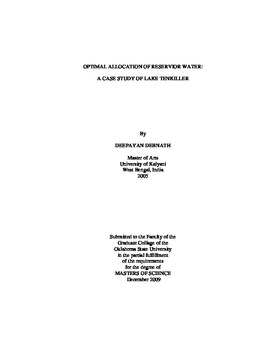| dc.contributor.advisor | Stoecker, Arthur L. | |
| dc.contributor.author | Debnath, Deepayan | |
| dc.date.accessioned | 2014-04-15T18:35:19Z | |
| dc.date.available | 2014-04-15T18:35:19Z | |
| dc.date.issued | 2009-12-01 | |
| dc.identifier.uri | https://hdl.handle.net/11244/8296 | |
| dc.description.abstract | The purpose of this study is to determine the optimal allocation of reservoir water among consumptive (urban and rural water supply) and non-consumptive (hydroelectric power generation and lake recreation) uses. An optimization model using non-linear programming is developed to optimally allocate reservoir water among competing uses. It is not unusual to determine recreation values along with flood control, hydropower generation and urban and rural water uses with recreation uses being treated as residual at best determined by maintaining reservoir level within specified range. In this study recreational benefits depend explicitly on the summer lake levels, while the flood control capacity of the reservoir is maintained through upper bounds on the lake level. A mass balance equation is used to determine the level and volume of water in the lake for each month over a twelve month period. General Algebraic Modeling System (GAMS) with the MINOS is used to solve this model. Results show that the total benefits arising from the use of reservoir water is increased under the optimization model compare to the benefits obtained under historical releases. We found that for Lake Tenkiller it is beneficial to consider the recreational values within the optimization model that would increase the overall benefits and the lake level should be maintained around the normal lake level of 632 feet during summer when the number of visitors is peak. An optimal allocation of water between competing uses requires that the marginal price of water at the lake in each month must be same for the last unit of water used for hydropower, recreation or urban and rural water uses. | |
| dc.format | application/pdf | |
| dc.language | en_US | |
| dc.publisher | Oklahoma State University | |
| dc.rights | Copyright is held by the author who has granted the Oklahoma State University Library the non-exclusive right to share this material in its institutional repository. Contact Digital Library Services at lib-dls@okstate.edu or 405-744-9161 for the permission policy on the use, reproduction or distribution of this material. | |
| dc.title | Optimal Allocation of Reservior Water: a Case Study of Lake Tenkiller | |
| dc.type | text | |
| dc.contributor.committeeMember | Boyer, Tracy | |
| dc.contributor.committeeMember | Sanders, Larry | |
| dc.contributor.committeeMember | Whitacre, Brain | |
| osu.filename | Debnath_okstate_0664M_10643.pdf | |
| osu.college | Agricultural Sciences and Natural Resources | |
| osu.accesstype | Open Access | |
| dc.description.department | Department of Agricultural Economics | |
| dc.type.genre | Thesis | |
| dc.subject.keywords | consumptive and non-consumptive uses | |
| dc.subject.keywords | mass balance equation | |
| dc.subject.keywords | non-linear programming | |
| dc.subject.keywords | optimization model | |
| dc.subject.keywords | recreational benefits | |
| dc.subject.keywords | reservoir management | |
